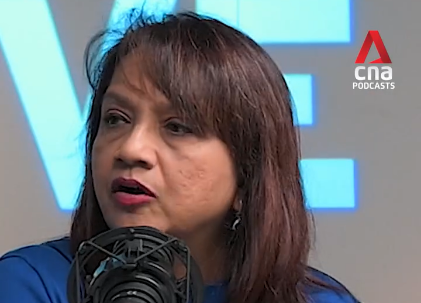-
Advocacy Theme
-
Tags
- Abortion
- Adoption
- Caregiving
- CEDAW
- Disability
- Domestic Violence
- Domestic Workers
- Harassment
- Healthcare
- Housing
- International/Regional Work
- Maintenance
- Media
- Migrant Spouses
- Migrant Workers
- Muslim Law
- National budget
- Parental Leave
- Parenthood
- Polygamy
- Population
- Race and religion
- Sexual Violence
- Sexuality Education
- Single Parents
- Social Support
- Sterilisation
- Women's Charter
AWARE deep dives with CNA into why victim-blaming is so dangerous
May 15th, 2025 | Gender-based Violence, News, Views
Sugidha Nithiananthan, the Director of Advocacy and Research at AWARE, talking about the misconceptions perpetuated by victim-blaming on the CNA Deep Dive podcast. Screenshot taken from Channel News Asia’s Instagram.
Article written by Athiyah Azeem.
A lot of people say that if you enter a dangerous situation, it contributes to the offence, said Steven Chia, host of CNA’s Deep Dive podcast.
“If your house was burgled and you left the door open, in court you can argue that, well, you left the door open.” Steven said on the podcast.
“Actually, you can’t,” said Sugidha Nithiananthan, the Director of Advocacy and Research at AWARE. “And that’s the whole point.”
Even if a door was left wide open, when a burglar walks in and steals the victim’s belongings, the burglar is still guilty of theft. Similarly, as long as a woman has not consented to sex, they are not to blame for being raped.
Sugidha used this analogy to explore the dangers and misconceptions that victim-blaming perpetuates with hosts Steven and Otelli Edwards on CNA’s Deep Dive podcast in April. She was joined by Mark Yeo, director of Fortress Law Corporation, who provided insight into how courts approach cases of sexual assault.
Sugidha spoke about this in the wake of former Vice President of the Law Society Chia Boon Teck’s infamous LinkedIn post. In his 10-point post, Chia used the fact that the survivor met the rapist through a dating app and sat in his bedroom to suggest that she consented to being raped.
“The fact that she decided to meet him through Tinder, or because she decided to get drunk at the bar, or because she followed him back to his room, none of this leads to consent,” Sugidha said. “It essentially always boils down to: Was there consent when it happened?”
Listen to this podcast episode to hear Sugidha dispel rape myths, and explain what consent is and why it’s so dangerous to blame survivors of sexual assault.
Here are some key takeaways:
- Victim-blaming is casting full or partial blame on victim-survivors for being raped.
- Victim-blaming incorrectly focusses on what the victim-survivor “did” to supposedly contribute to causing the rape, instead of focussing on the perpetrator who is solely responsible for causing rape.
- There is no one way to be a victim-survivor. Sometimes, survivors freeze and are not able to say “no.” Sometimes, survivors fawn and keep in contact with the rapist after being raped. Rape is not about what the survivor did, but whether they consented to sex.
- Rape myths are untrue beliefs people hold about why a victim-survivor was raped (e.g. “she was asking for it.”)
- People still believe in rape myths, which present in myriad ways:
- Comments perpetuating rape myths that go unchallenged in casual conversations.
- Myths are used to excuse perpetrators in court.
- Men believing a woman they are meeting is consenting to sex because they’re wearing something revealing.
- Survivors not wanting to report being raped because of the fear of being disbelieved.
- Rape myths obfuscate the truth: That you cannot assume, manipulate, or coerce consent.
- Consent education goes a long way in helping people understand consent, navigate sexual situations, and communicate what they want from a sexual partner.
- It’s important to teach consent to people when they are young, so they are well-informed when they’re older, when they are navigating sexual situations.
Athiyah Azeem is the Communications Executive at AWARE.




